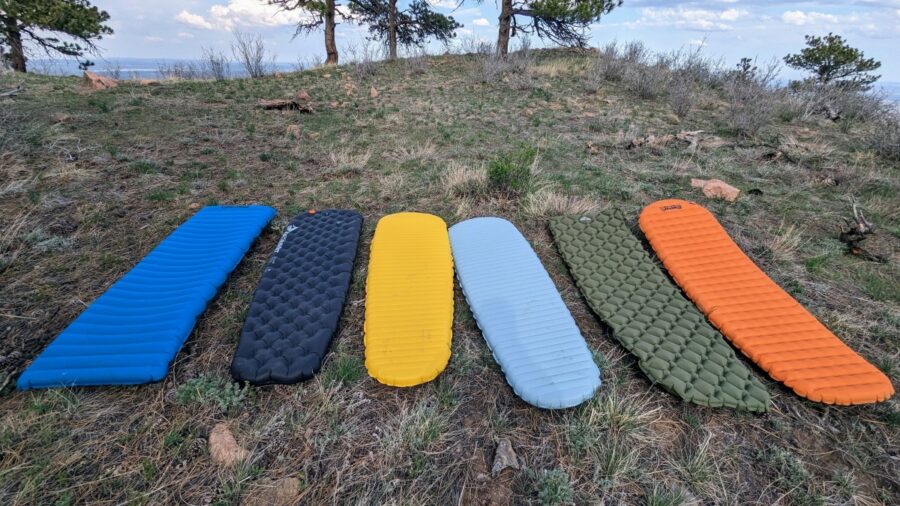If you’re wondering, “How can I make my backpacking sleep more comfortable?” You’re in the right place. Since you can pack many things when camping, especially if you’re car-camping, several pieces of sleeping gear can make your experience a lot more comfortable. However, regarding backpacking sleeping gear, you must find the right balance between comfort and functionality, as packing light is also part of the equation.
In both cases, the sleeping bag usually steals the spotlight. Yet, having a reliable sleeping pad is no less critical. A sleeping pad is just as important as a mattress at home; a quality option will keep you warm, cozy, and lighter with your pack, shifting hours of uncomfortable turning and tossing (sometimes getting no sleep at all) into a comfy sleeping night.
How to Choose a Sleeping Pad for Hiking and Camping?

Like everything else in your backpack, you must consider a few things when choosing a comfortable, lightweight hiking sleeping pad. When looking at the different sleeping pad types, sizes, and insulation materials, consider the time of year you’re going hiking or camping, as well as pack space and weight concerns. Whether you’re a side, back, or stomach sleeper is also essential.
Consider the Different Types of Sleeping Pads
Manually-inflated, self-inflated and closed-cell foam designs are the main hiking sleeping pad designs. Here’s what you need to know about each sleeping mat type.
Manually-inflated Sleeping Pads
This sleeping pad type is lightweight, easy to use, and requires inflating with a pump or blowing into a valve. It’s ideal if you’re looking for the lightest option that still offers cushioning and is appropriate for side sleeping.
These pads are lightweight, incredibly packable, and highly cushioned because of their open-core construction, which features separate baffles that expand with air. They are frequently 2.5 to 3 inches thick. Some are also suited for usage in cold climates since they include a coating of insulating foam or heat-reflecting materials.
Any inflated sleeping pad has a drawback: the risk of punctures. Even though their design can withstand heavy use, an invisible rock or jagged twig can cause considerable harm. Should they become punctured, you can buy a simple repair kit sold separately or supplied with the pad to restore it to its original state.
Self-inflating Sleeping Pads
Self-inflating sleeping pads are comparable to manually inflated pads; however, they contain an open-cell foam layer that automatically inflates the pad rather than an open-core, baffled structure. The open-cell foam expands and fills with air when the valve is opened, saving you time and effort while getting your bed ready for the night.
A little more manual inflation is usually needed to achieve the desired hardness—just a few breaths. Repair kits are provided or available separately because self-inflating air pads, like manually inflated air pads, are at risk of puncturing.
While self-inflating and manually inflating pads are very similar and have the same usage, opt for a self-inflating pad for ease of use (in a slightly heavier, bulkier package).
Closed-Foam Sleeping Pads
The most basic type of sleeping pad is the closed-cell foam model, constructed from solid foam with tiny closed-air cells inside. These pads frequently feature a metallic, heat-reflective covering on one side to add warmth. They are the most economical, long-lasting, and remarkably light.
They’re also fantastic for spontaneous breaks because you can toss them anywhere on the ground for a seat during lunch or a midday siesta. They don’t need to be inflated or deflated and won’t burst.
This type of sleeping pad provides little padding, which is its main disadvantage; a closed-cell foam construction provides around half an inch. Because there’s no cushioning on the side for side sleepers, they’re best suited for back sleepers who experience pressure spots during the night.
You will need to affix a closed-cell foam sleeping pad to the exterior of your backpack, as they can only be folded or rolled. Even though their incredibly light weight makes that a minor price to pay, it might be annoying if your pad becomes tangled in trees or other dense vegetation when hiking on heavily wooded or enclosed trails.
Choose the Right Size and Shape

The diversity of sizes available in sleeping pads can accommodate different demands. Given that they come in inches and centimetres, it’s simple to figure out what size pad you require based on height and weight.
Selecting a sleeping pad a few inches longer than your height is essential to prevent your feet from hanging off the end, as contact with the ground can cause a significant loss of body heat. Sometimes, thru-hikers or others going on lengthy, ultralight excursions will choose a smaller pad and then stuff additional garments or a pack beneath their legs to maximize weight and packability at the expense of a small amount of comfort.
It’s crucial to consider your sleeping pad’s width and form in addition to its length. Most regular-sized sleeping pads have a mummy shape and are 20 inches wide, which works well for average-sized campers when balancing comfort, weight, and packability. A more comprehensive (large sizes of sleeping pads add 5 inches to the width, making them 25 inches wide) or rectangular-shaped sleeping pad can be a better option if you are a larger person or feel like you need more room to move around at night.
Don’t Forget About Insulation
Insulation is one aspect of a sleeping mat that’s simple to ignore. A sleeping pad’s ability to keep its user warm from the ground is measured in its R-value, which ranges from 0 to 6. It will be warmer if the R-value is higher. In addition, certain sleeping mats employ materials that reflect heat toward you from your body, preventing it from escaping to the floor.



